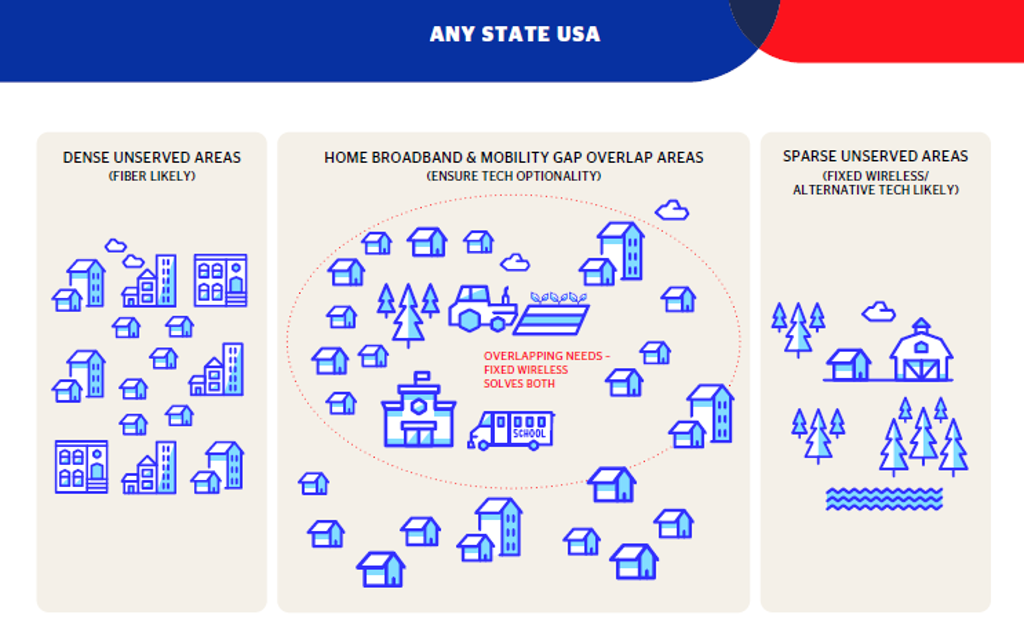UScellular “Fact Checks” Broadband’s Hottest Topics
5G Fixed Wireless Access (FWA) is an exciting broadband technology that beams radio spectrum from macro sized cell towers, connected by fiber, to many locations simultaneously. It provides life-changing, reliable, high speed home internet to places that have historically lacked access to the many essential benefits of a connected lifestyle.

Myth: 5G Fixed Wireless Access (5G FWA) does not offer the high speeds required by the Infrastructure Investment and Jobs Act for home broadband internet access.
FALSE! 5G FWA reliably delivers 100 Mbps down and 20 Mbps up, as required by Congress. In addition, 5G FWA is scalable to even faster speeds using multiple spectrum layers and emerging technologies. Many states will benefit from 5G FWA as part of their state plans.
Myth: States are empowered to design Broadband Equity Access & Deployment (BEAD) plans that meet their unique needs.
TRUE! Each state will have its own broadband deployment priorities and will need to determine how best to spend its allocation of BEAD funding. Some states will have enough BEAD funding to deploy fiber everywhere. In these states, they should. However, in many states, there will not be enough funding for fiber alone or fiber alone might be impractical, especially in rural or topographically challenged geographies. States decide the right mix of reliable broadband technologies and, where possible, can reserve funds to invest in other priorities like providing subsidies to make the technology more affordable to its residents.
Myth: The BEAD program can only address the home internet gap, not the mobile service gap.
FALSE! 5G FWA delivers a 2-for-1, home and mobile, technology solution. The same investments made for fixed wireless will also provide mobile broadband service. This multiplier effect is essential in areas that lack mobile coverage today.

Myth: Americans want all forms of broadband connectivity – home internet & mobile.
TRUE! Americans value connectivity everywhere. They don’t want to be tethered to any one place. That’s why the 2-for-1 benefit of 5G FWA – providing both fixed and mobile broadband – is so important. A recent report from Mobile Experts found that Americans ascribe 20x more value to mobile service when looking at the acceptable cost per gigabyte — we know this from experience, most of us would return home if we accidentally left without it. Over half of the Affordable Connectivity Program (ACP) low-income recipients choose wireless. With ACP and other programs that support digital inclusion, it’s possible for all Americans to be connected.
Myth: Deploying fiber or 5G FWA is an “either-or” decision; each technology stands on its own.
FALSE! Fiber and wireless technologies complement each other to enhance the broadband experience. “Hybrid” deployments that use both licensed wireless spectrum and fiber are often the way to effectively connect rural areas where expensive last-mile fiber-to-the-home connections can otherwise restrict access to the benefits of a digital economy.
Myth: 5G FWA and Fiber have similar deployment costs and timelines.
FALSE! 5G FWA can be deployed faster and at lower costs than fiber and other technologies, while still being reliable and resilient and with a roadmap for the future. The typical time to build a cell tower for 5G FWA from permitting to service availability averages 18 months, much quicker than most fiber deployments, particularly in rural areas. And coverage is near immediate if the tower already exists. With wireless, deployment time goes from “years to months,” to many more people, as noted by Tarana Wireless. SNS Telecom & IT states, “the last-mile FWA deployment costs as much as 40% less than Fiber to the Premise,” stretching available funds to complete the job of universal broadband availability.
Myth: Broadband downlink and uplink usage is the same (a.k.a. symmetrical usage).
FALSE! Actual broadband downlink demand, before, during and after the pandemic, is 12-14 times greater than uplink demand (a.k.a. asymmetrical usage). Rules requiring symmetry limit choices and ignore usage trends.
Myth: Fiber is the only “future proof” technology.
FALSE! Wireless technology, including 5G FWA, is at the center of global innovation. With a growing portfolio of exclusively licensed spectrum and technological advances, 5G FWA is reaching new heights in service excellence and providing scalability in ways other technologies cannot. 5G FWA is pushing the edges of distance, without the historical challenges of line of sight, and forecast throughput at multigigabit levels. Coupled with a burgeoning ecosystem of customer premises equipment, 5G FWA is a future proof technology, making it an excellent choice for public investment.
Myth: 5G FWA Home Internet adoption is accelerating.
TRUE! 5G FWA Home Internet is growing at rapid pace, both globally and in the United States. The Leichtman Research Group recently reported that 5G FWA captured 90% of new U.S. customers in 2022 and indications are that will continue in 2023. Additionally, Wolfe Research reported these same FWA customers enjoying high levels of consumer satisfaction with 90% “mostly satisfied.” As providers deploy mid-band spectrum, speeds get even faster, and growth will further accelerate.
Myth: Measuring wireline and wireless availability works the same way.
FALSE! With wired connections, determining address level availability is based upon the 1:1 nature of the physical connection needed. Actual performance upon that connection may vary based upon elements including transport capacity along each leg of a connection path and determination of reliability (i.e., aerial vs trenched service). For wireless technologies, variables in spectrum depth, tower size, and antenna strength, along with terrain, and distance factors determine broad service areas. The FCC establishes the parameters for models that predict wireless coverage.
References:
HR 3684 Infrastructure Investment and Jobs Act Division F, Title 1, Section 60102, Definitions
NTIA BEAD NOFO, (C) Definitions, (u) Reliable Broadband Service, Page 15
FCC Broadband Data Filing Rules https://us-fcc.app.box.com/v/bdc-availability-spec
UScellular Tech Demo https://newsroom.uscellular.com/uscellular-5G-FWA-in-Iowa/
Leichtman Research Group – Wolfe Research https://www.lightreading.com/broadband/fixed-wireless-access-(fwa)/fwa-captures-90-of-all-new-us-customers-pleasing-around-90-of-them/d/d-id/783658
Recon Analytics https://www.fiercewireless.com/wireless/fixed-wireless-customers-give-high-nps-scores-service-entner
SNS Telecom https://www.snstelecom.com/5gfwa Accenture CTIA https://www.ctia.org/news/5g-fixed-wireless-broadband
Mobile Value: https://www.fiercewireless.com/wireless/consumers-ascribe-20x-more-value-mobile-broadband-fixed
Tarana Wireless: https://www.taranawireless.com/waiting-and-waiting-for-broadband/
